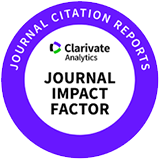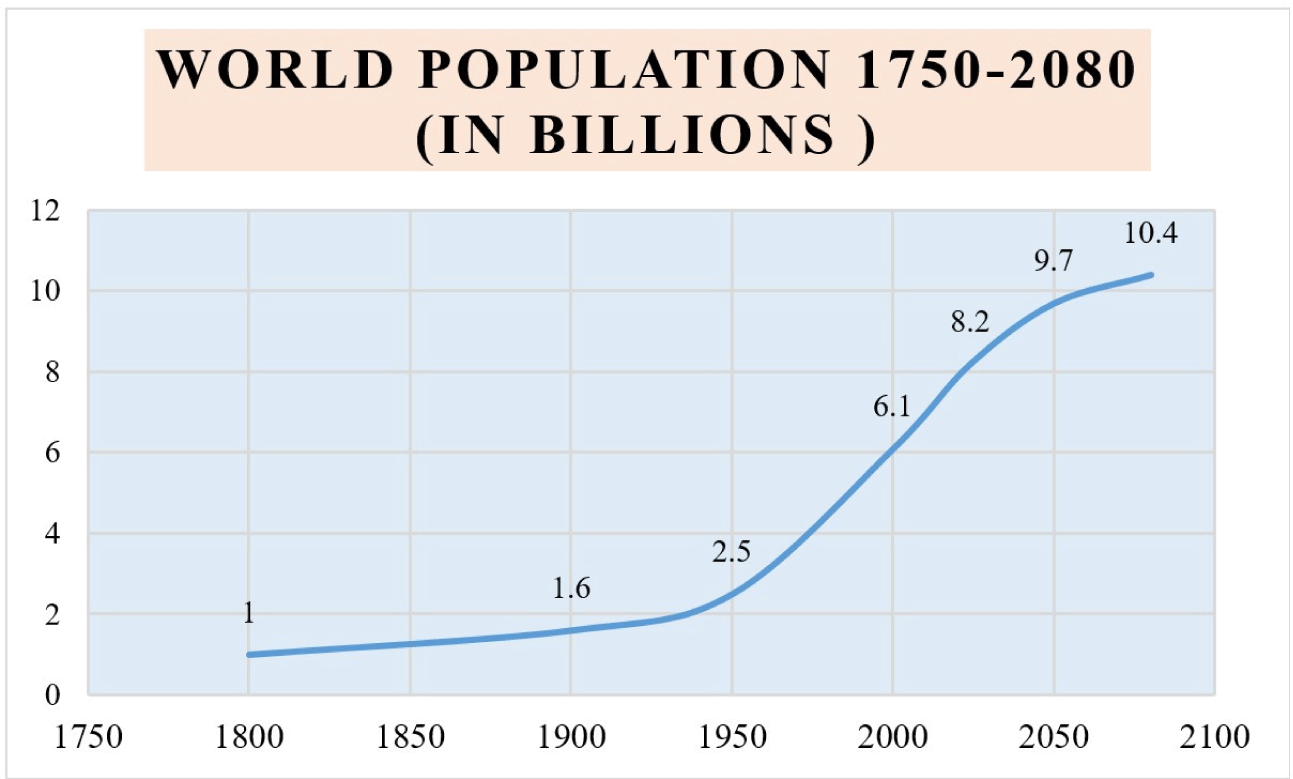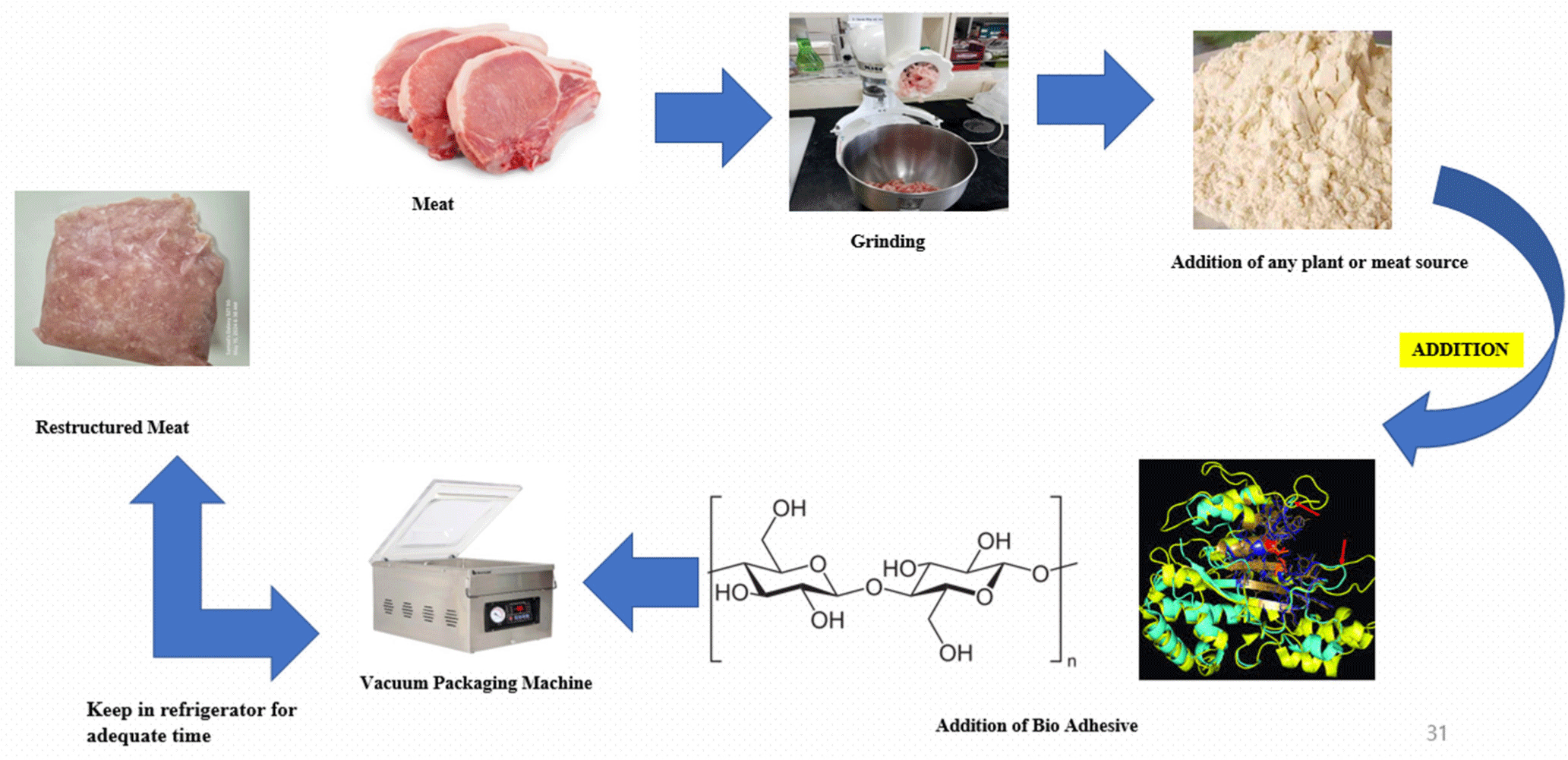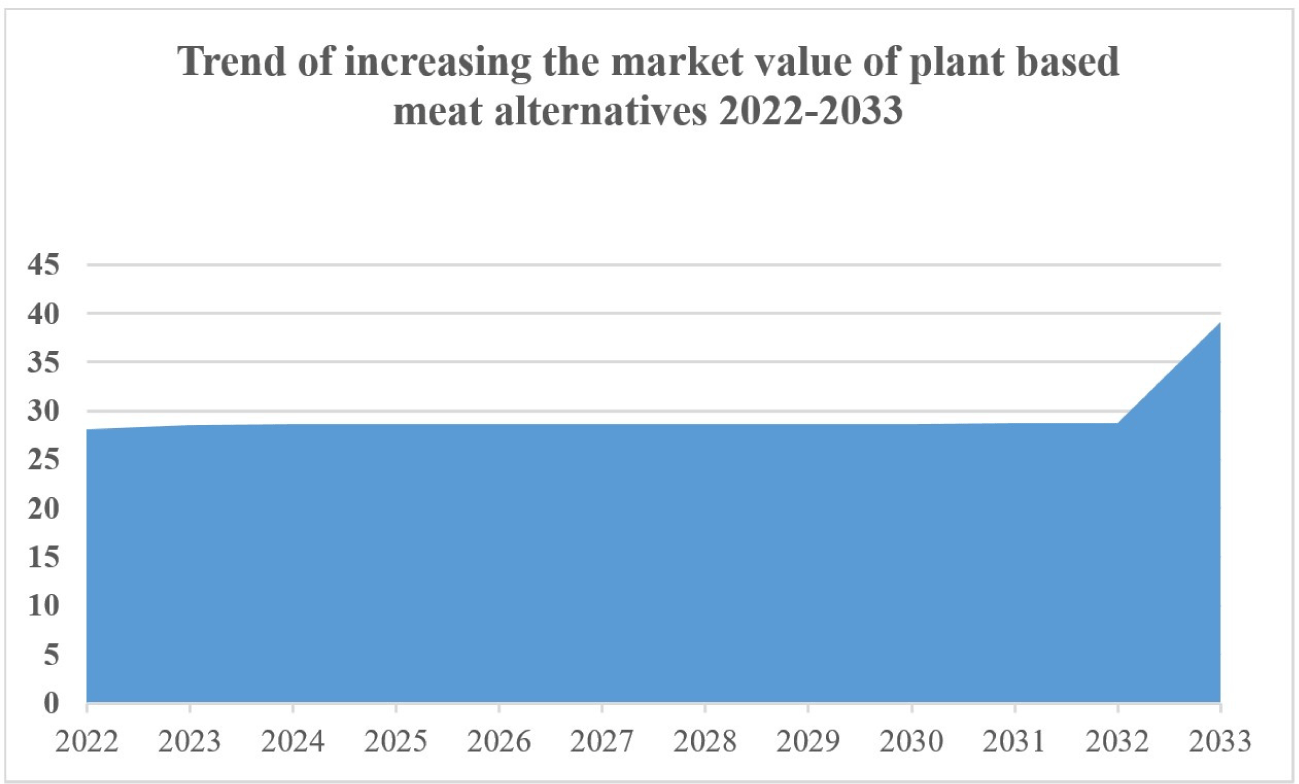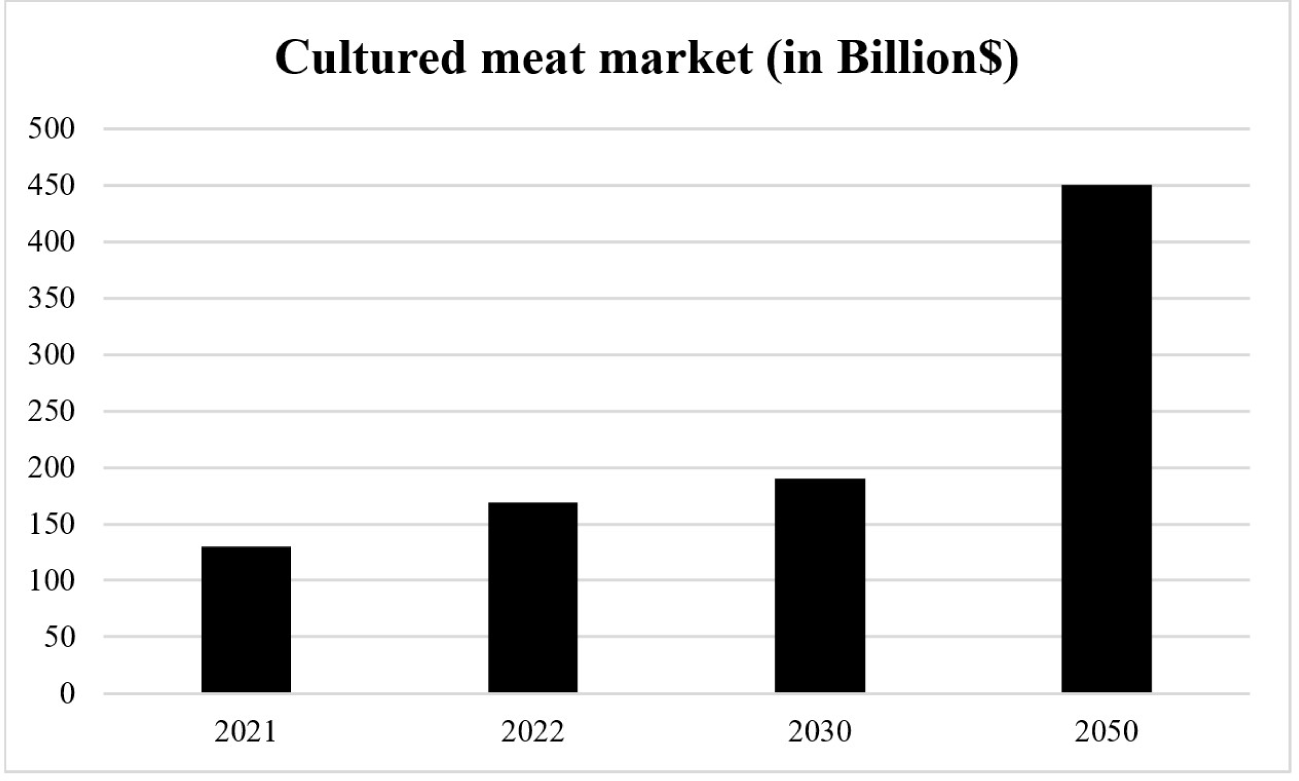Introduction
History of using meat as an important component of human diet is 2.6 million years old (Heidemann et al., 2020). Initially, humans hunted animals, but after sometime, to facilitate the free access to meat, human started domesticating birds and livestock, including pigs, chicken and cattle. The world population is increasing day by day. There are 8.1 billion people who are currently living on this planet (Food and Agriculture Organization [FAO], 2015), and it is predicted that by 2050, this number will touch 9.7 billion (FAO, 2015); further, by 2080, the number of people on this planet will be 10.4 billion (FAO, 2015) while the trend of increasing population is shown in Fig. 1. The FAO-UNO stated that a significant challenge in meeting demand of food would arise due to lack of food resources while the demand is projected to increase by 70% due to the growing global population (FAO, 2009). There are many meat alternatives which are being used in place of conventional meat to cover some portion of meat demand, e.g., plant-based meat (Bakhsh et al., 2021a; Kumari et al., 2023; Samad et al., 2024a), restructured meat (RM; Samad et al., 2024b), cultured meat (Kim et al., 2024; Samad et al., 2024c), hybrid cultured meat (Alam et al., 2024), mycoprotein meat alternatives (Shahid et al., 2024) and insect-based protein alternatives (Anusha Siddiqui et al., 2023).
As the search for sustainable and efficient food sources intensifies, the meat industry is undergoing a significant transformation with the rise of lab-grown and alternative proteins (Mylan et al., 2023). This change shows a growing awareness of the environmental and ethical implications of conventional meat production. Cultivated or cell-based meat shows an innovative approach where there is no need to slaughter animals, as in cultivated or cultured meat, animal cells are grown in controlled conditions to produce meat (Soleymani et al., 2024). This method not only has the potential to reduce land use and greenhouse gas emissions but also has a positive correlation with animal welfare in terms of minimizing the requirement of rearing animals in livestock farms (Treich, 2021).
In addition to cultivated meat, other meat alternatives are also progressing, such as plant-based meats. Plant-based products are rapidly growing because of their climate-friendly nature and health benefits (Dueñas-Ocampo et al., 2023). Hybrid cultured meat, which has conventional meat with cultured cells, accommodates traditional and lab-grown ways (Alam et al., 2024). Simultaneously, proteins derived from insects and fungi-based mycoproteins are becoming more useful sources of protein and can be used as meat alternatives because of their health benefits and less environmental impact than traditional meat production (Anusha Siddiqui et al., 2023). This progress shows a crucial step toward resolving the demanding problem of the increasing worldwide population and demand for reliable food systems (Galanakis, 2024). With changes in technology and customer choices, the future of various alternatives to meat ensures the provision of a great range of options that can fulfill the nutritious needs of billions, along with encouraging environmental handling and moral practices.
This review explores the revolutionary landscape of different meat alternatives, with a focus on technological advancement and novel approaches that are revolutionizing the future of food. This review brings light on the various meat alternatives, insect-based meats, cultured meat, plant-based meat, and hybrid options. This review contains ways of production, environmental impacts, and their ability to cope with increasing worldwide food demand. By assessing the pros and cons linked with each alternative, this review aims to provide a detailed comprehension of the emerging technologies that could contribute to a more reliable and ethical food system. This thorough analysis will guide future research and decision-making in food science and sustainability.
From Farm to Lab
There are various factors, including environmental concerns, health benefits, and animal welfare, have driven the shift from traditional farming to meat alternatives (de Boer and Aiking, 2022). Meat analogs are also described as mock meat and imitation meat. The process of replacing meat in food products is not entirely new; it was started at the beginning of the 1960s (Ismail et al., 2020). Usually, soy proteins in tofu and tempeh (fermented cake of soybean) are widely used in meat analogs. These components have undergone processing and have been utilized for centuries as traditional cuisines in Southeast Asia since as early as 956 CE (Gopi et al., 2023). In addition to these traditional Asian products, texturized vegetable protein (TVP) obtained from pressed defatted soy meals, wheat gluten, and concentrates from soy protein were first introduced as a meat analog (Baune et al., 2022). The launch of this TVP as an alternative to meat arose in the second half of the 20th century (Bakhsh et al., 2021b).
TVP has an elastic and foamy texture and is suitable for use as a meat alternative (Zimberoff et al., 2021). Usually, TVP is made from soybeans. Texturized soy protein, due to its meat-like surface attributes, is an exceptionally universal food component, and protein quality is also similar to animal proteins (Bakhsh et al., 2022). Although vegetable protein components are cost-effective sources, they can be altered into amazing meat alternatives such as preserved meat (Kurek et al., 2022), meat alternatives in beef patties, and pet meals (Jiang et al., 2020). However, adopting plant-based diets could be challenging for some people (Canseco-Lopez and Miralles, 2023). There may be various associated challenges, such as an intense off-taste for soybean-extracted products (Zioga et al., 2022). The taste is due to isoflavones, saponins, and lipoxygenase activity, which reduce the use of soy-based protein as a meat alternative (Wang et al., 2022). The other major concern is the allergic effect of food protein in legume crops such as common beans, lentils, and soybeans (Abu Risha et al., 2024), which has limited the development of meat analogs from these plant-based sources. Furthermore, cereal proteins such as wheat, rye, barley, etc., are also toxic for individuals with gluten intolerance.
At the beginning of the 21st century, due to the demand for healthy food, meat analogs became popular. The reliable implications of consumers’ diets continuously arise along with other choices for traditional meat (Lawrence and King, 2019). During the last 10 years, recent technological advancements in food science and its manufacturing have been introduced in meat alternative products that have the potential to imitate the flavor, appearance, texture, and functionality of traditional meat-based products (Lawrence and King, 2019). Currently, the main focus is on the direct manufacturing of novel protein sources in meat alternatives such as lab-based and plant-based meat. This advanced technology will help to cope with the restrictions of using traditional protein-based, specifically from cereals and legumes. In recent years, edible insects have been expected to be a good alternative to human foods because of their good fat content and high protein content. The supermarket chain in Germany and Switzerland had already started selling balls of mealworms and burger patties of insects. However, in North America and Europe, an increasing number of insect-based protein products for human intake have also been reported (Verbeke et al., 2015).
Plant-based meat alternatives are good protein sources, and their continuity, nutritional value, color, and taste are similar to conventional meat (Kumari et al., 2023). Conventionally, plant-derived meat alternatives are manufactured based on years-old protocols (Joshi and Kumar, 2015). To make a final product that seems like meat, soy-based proteins, lentils, rice, wheat gluten, and mushrooms were all processed with meat-like taste additives (Joshi and Kumar, 2015). Soybean-derived tempeh and tofu are the most common plant-based meat alternatives. Different plant-based proteins, such as gluten from wheat, are also used in traditional foods such as seitan (Dekkers et al., 2016). Plant-based meat alternative analogs are based upon TVP, an extensive dry product that is derived from soy constituents (Boukid, 2024). Analogous substances are those that have the same structure as each other but differ slightly in their makeup. Mimic meat or meat alternative in this situation is a food provision that looks similar in structure but significantly differs in its makeup (Bohrer, 2019). Meat substitution, vegetarian meat, meat alternative, amalgam meat, mimic meat, processed meat, or plant-based meat are the terms used alternatively (Rooney and Muller, 2023). Mock meat also has almost the same properties, such as consistency, flavor, and texture, and it also has chemical-based properties similar to different kinds of meat (Adam et al., 2024).
Due to the global demand for reliable meals as a result of animal-based foods involvement as well as other environmental factors, organizations have enlarged their focus on manufacturing meat alternatives (Henchion et al., 2021). The market for alternative meat depends upon meat reducers; meat reducers are the consumers who are interested in maintaining weight and health (Apostolidis and McLeay, 2016). There are several health benefits of eating meat alternatives, and lowering meat intake may prove helpful in reducing cholesterol levels and also minimizing cardiac problems; daily original meat intake is linked with colorectal cancer. Researcher’s interest in plant-based meat is increasing due to high demand by consumers because of health issues connected with daily meat intake or due to obligatory consumption of vegetable-based diets in specific religious sects. New technologies that are developed in the sector of plant-based meat alternatives are explained in Table 1. Furthermore, Fig. 2 also shows the technological advancement in the form of 3D printing in plant-based meat sector.
| Development area | Description | Reference |
|---|---|---|
| 3D Printing | Researchers have developed plant-based meat alternatives using 3D printing technology. Ingredients like soy and wheat proteins, along with cocoa butter, are used to create a meat “dough” that can be effectively printed and retains its shape after printing. Fig. 2 explains the process of 3D bioprinting in plant-based meat alternatives more clearly. | Science Daily (2021) |
| Protein spinning | Fiber-spinning technology is being optimized to develop plant-based meat analogs. This involves extruding fine fibers from soy protein and polysaccharides, which are then assembled into structures resembling muscle fibers. | Kumari et al. (2024) |
| Plant protein materials | Studies are exploring various plant proteins (e.g., lentils, soybeans, peas, buckwheat) for 3D printing to meet the growing demand for meat alternatives. | Auyeskhan et al. (2024) |
| Innovative textures | Companies like Alt Farm are using patented nozzle designs in 3D printing to recreate specific textures in plant-based meats, enhancing their resemblance to real meat. | 3DR Holdings (2021) |
| Fermentation | Companies are using fermentation to enhance the flavor and texture of plant-based meats. This process involves using microorganisms to break down plant proteins, creating a more meat-like taste and texture. | Zioga et al. (2022) |
| Cellular agriculture | Some companies are combining plant-based ingredients with cultured animal cells to create hybrid products that offer the taste and texture of real meat with the sustainability of plant-based ingredients. | Rubio et al. (2020) |
| High-moisture extrusion | This technique is used to create fibrous, meat-like textures from plant proteins. It involves heating and shearing plant proteins under high moisture conditions to align the protein fibers, mimicking the texture of meat. | Guyony et al. (2023) |
| Flavor enhancements | Advances in flavor technology are helping to close the gap between plant-based and animal-based meats. Natural flavors and aroma compounds are being developed to replicate the taste of beef, chicken, and pork. | Liu et al. (2023) |
| Nutritional improvements | Efforts are being made to enhance the nutritional profile of plant-based meats by fortifying them with vitamins, minerals, and other nutrients to match or exceed the nutritional content of animal-based meats. | McClements and McClements (2023) |
| Mycoprotein development | Mycoprotein, derived from fungi, is being developed as a sustainable and nutritious meat alternative. It offers a meat-like texture and is rich in protein and fiber. | Molfetta et al. (2022) |
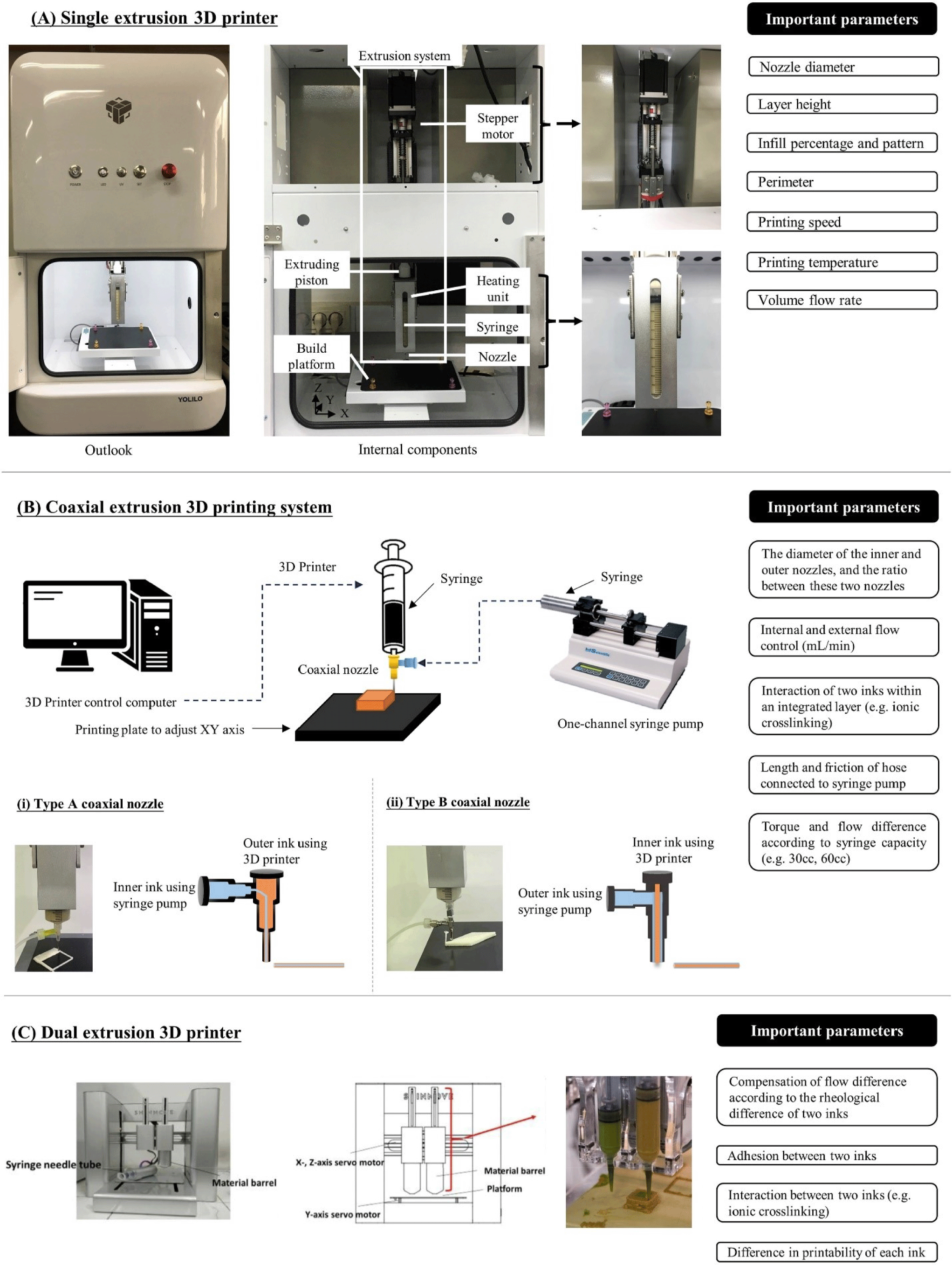
The conversion of different ingredients, including meat or vegetable protein, into an innovative product with enhanced nutritional value is termed as RM (Samad et al., 2024b). The composition of RM is depends upon the binding agents as these agents are responsible for the proper texture or structure of final product (Carpentieri et al., 2022). The potential of RM relates to the sustainability of the meat business by utilizing less used meat cuts or by-products that are being wasted due to no or less demand. RM is an opportunity to combine less used parts of meat components with traditional, inexpensive sources of plant protein to develop a new product with good physiochemical properties. Various methods, such as meat restructuring and hybrid meat (HBM), have been utilized to transform meat in order to integrate health benefits (functional components) from alternative sources, including plants (Mireles-Arriaga et al., 2017) and other protein sources (Baugreet et al., 2018). RM may serve as an advantageous option for health-conscious individuals seeking to diminish their meat consumption. Fig. 3 delineates the process of RM. Table 2 delineates recent trends in RM output.
| Development | Description | Reference |
|---|---|---|
| Hot-set gels | It uses thermal processes to form gels that bind small meat pieces together, enhancing texture and appearance. | Zheng et al. (2015) |
| Cold-set gels | Utilizing chemical reactions to bind meat pieces without heat, preserving more nutrients and flavors. | Gómez et al. (2020) |
| High-pressure processing (HPP) | Applying high pressure to bind meat pieces improves texture and reduces microbial load. | Rajendran et al. (2022) |
| Alternative protein integration | Incorporating plant-based proteins into restructured meat to reduce meat content and environmental impact. | Sha and Xiong (2020) |
| Enhanced sensory attributes | Improving the taste, texture, and appearance of restructured meat products to make them more appealing to consumers. | Gadekar et al. (2015) |
One of the most sustainable options is cultured meat. The expansion of stem cells facilitates the generation of cultured meat. In 1894, French scientist Marcellin Berthelot proposed the notion of generating food products by culturing techniques, contending that industrial facilities could manufacture eggs, dairy, and meat (Shapiro, 2024). The cultivation of food products began in 1894. Self-replicating steaks were described by British India Secretary Frederick Smith in 1930. It was proposed that meat may be produced on a large scale using progenitor cells (Kirsch et al., 2023). In the UK, Gregory Sims produced and commercialized the first plant-based burger in 1982, establishing the foundation for the production of meat replacements (Woodholme Cardiovascular Associates, 2020). In 1995, the Food and Drug Administration (FDA) approved culturing or in-vitro techniques for cost-effective meat production (Stephens et al., 2019). The first commercially viable production of cultured beef occurred in 1999 (Kirsch et al., 2023). In 2013, Mark Post first developed grown meat with bovine muscle cells as the major source at Maastricht University, Netherlands (The Guardian, 2013). Consequently, numerous researchers initiated their investigations into cultured meat production. Fig. 4 elucidates the process of cultured meat. Table 3 shows the recent technological advancements in cultured meat production.
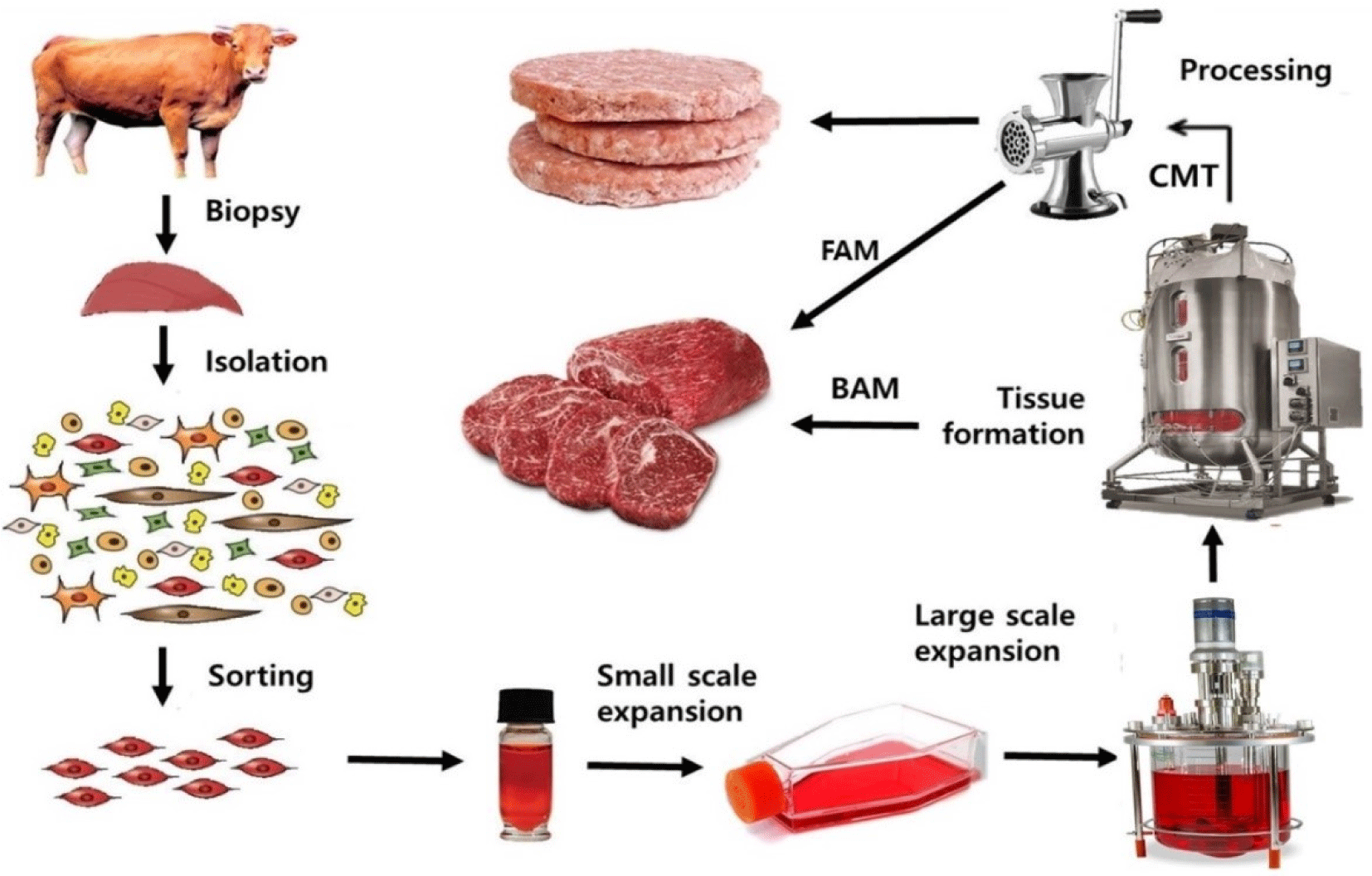
| Advancements in cultured meat production | Description | References |
|---|---|---|
| Fused deposition modeling (FDM) | This strategy is used to make a framework using thermoplastic biomaterials. | Lee and Choi (2024) |
| Stereolithography (SLA) | SLA is a cost-effective approach that assists in the fast manufacturing of prototypes. | Kafle et al. (2021) |
| Selective laser sintering | This 3D printing strategy fuses or binds small charged materials together by using powerful lasers which create a solid arrangement. | Han et al. (2022) |
| Biomimetic scaffolds | This approach presents a novel strategy for 3-dimensional cell culture approaches that could be utilized in tissue engineering. | Badekila et al. (2021) |
| Cultured fat | Fats which are cultured in the lab using adipose tissues | Liu et al. (2023) |
| Soft bioreactors | The bioreactor can refine the rate of production | Dvorak et al. (2024) |
| Serum-free media | Such media contains a nutritional formulation that needs cells for their progress and is free of any animal-based serum. | Zhang et al. (2024) |
Insect-derived meat substitutes are emerging as a sustainable and healthy alternative to conventional meat (Anusha Siddiqui et al., 2023). Insects are abundant in protein, vital amino acids, omega-3 and omega-6 fatty acids, iron, and zinc (Oonincx and Finke, 2021). They necessitate reduced area, water, and feed relative to conventional livestock and emit fewer greenhouse gases (van Huis and Oonincx, 2017). Notwithstanding these advantages, consumer adoption continues to pose a difficulty, especially in Western nations, owing to issues such as food neophobia and unfamiliarity (Siddiqui et al., 2022). Nonetheless, heightened awareness of their nutritional and environmental advantages may enhance acceptability. Insects can be transformed into diverse forms and integrated into goods such as protein bars, snacks, and RM (Borges et al., 2022).
Insects are a significant source of nutrients. They comprise 13%–77% protein by dry weight, rendering them a highly effective protein source (Sujatha et al., 2024). The protein content fluctuates based on the species and developmental stage. Crickets and mealworms are notably rich in protein (Stone et al., 2019). Besides protein, insects offer vital amino acids that are required for human health. Lysine, methionine, and cysteine are frequently deficient in plant-based diets. Moreover, insects are abundant in healthful lipids, encompassing omega-3 and omega-6 fatty acids, which are advantageous for cardiovascular health. They also encompass vital micronutrients, including iron, zinc, magnesium, and B vitamins, which are crucial for numerous physiological activities (Oonincx and Finke, 2021).
A primary justification for exploring insect-based meat replacements is their little environmental impact. Conventional cattle agriculture is resource-demanding, necessitating substantial quantities of land, water, and feed. Conversely, insect farming exhibits remarkable efficiency. Insects can be cultivated on organic waste, so diminishing the necessity for feed and contributing to waste management. They necessitate considerably less water and area than cattle, pigs, and chickens. Producing 1 kg of insect protein takes around 2 liters of water, while the equivalent quantity of animal protein demands almost 15,000 liters of water.
Moreover, insects emit significantly lower amounts of greenhouse gases. Animals such as cattle are the main source of methane and nitrous oxide emission while both are the powerful greenhouse gases. On the other hand, insects produce less gases, which is making them a more environmentally sustainable option. Insects can be transformed into diverse forms to enhance their palatability and versatility. They can be pulverized into powders, which may subsequently serve as components in various food products. Ongoing research and development, coupled with heightened consumer awareness, may enable insect-based meals to emerge as a predominant protein source in the future. Table 4 shows the recent trends in insect-based Protein alternatives.
| Development | Description | Reference |
|---|---|---|
| Bioactive peptides from insects | Researchers are exploring the use of insect proteins as substrates to obtain bioactive peptides, which have potential health benefits. | Teixeira et al. (2023) |
| Insect protein as bio-converters | Insects are being studied for their ability to convert various grades of waste into food or feed proteins, offering an efficient and sustainable protein source. | Piercy et al. (2023) |
| Insect-based protein startups | Several startups are leading the industry by developing innovative insect-based protein products for human consumption and animal feed. | Grasso and Bordiga (2023) |
| Consumer acceptance studies | Studies are being conducted to understand and improve consumer acceptance of insect-based proteins, focusing on overcoming cultural barriers and food neophobia. | Szulc (2023) |
| Nutritional and environmental benefits | Insect proteins are recognized for their high nutritional value and low environmental impact, making them a sustainable alternative to traditional livestock proteins. | Gasco et al. (2020) |
Market Trends of Meat Alternatives
The global plant-based meat market was valued at $6.1 billion in 2022, with significant growth in regions like Latin America and Europe (Caputo et al., 2024). Despite a slight decline in U.S. retail sales, the long-term trend shows a tripling of sales over the past decade. The category has opportunities to improve consumer engagement by focusing on taste parity, affordability, and effectively communicating health benefits. The trend of the plant-based meat market is shown in Fig. 5.
Market insights: RM products, which include plant-based and HBM products, are gaining traction due to their ability to mimic the texture and taste of conventional meat (Rai et al., 2023). Innovations in this category are driven by advancements in food technology and consumer demand for healthier and more sustainable options. Market trends of RM are elaborated in Table 5.
| Aspect | Value | Source |
|---|---|---|
| Global market size (2023) | $4.6 billion | Rai et al. (2023) |
| Key regions | North America, Europe, Asia-Pacific | Samad et al. (2024b) |
| Top companies | Tyson Foods, Cargill, JBS | Howard (2019) |
| Consumer preferences | Low-fat, low-salt, high-fiber | Campagnol et al. (2023) |
| Environmental impact | Reduction in waste, sustainable production | Pintado and Delgado-Pando (2020) |
Market potential: Cultured meat, also known as lab-grown meat, is still in its nascent stages but holds significant promise (Chodkowska et al., 2022). The market is projected to grow as regulatory approvals increase and production costs decrease. Companies are focusing on scaling up production and improving the taste and texture to match conventional meat. While consumer acceptance is gradually increasing, there are still challenges related to perception and cost. The market scenario of cultured meat is elaborated in Fig. 6.
Insect-based meat is emerging as a sustainable and protein-rich alternative (Malila et al., 2024). The market is expected to grow as consumers become more aware of the environmental benefits and nutritional value of insect protein (Khayrova et al., 2024).
We compare meat alternatives based on available references. The comparison is shown in Table 6.
| Aspect | Plant-based meat | Restructured meat | Cultured meat | Insect-based meat |
|---|---|---|---|---|
| Market value | $6.1 billion in 2022 (Caputo et al., 2024) |
Growing due to advancements in food technology (Samad et al., 2024b) |
An emerging market with high growth potential (Chodkowska et al., 2022) |
Expected to grow with increasing awareness (Malila et al., 2024) |
| Consumer acceptance | High, but needs improvement in taste and affordability (Gradl et al., 2024) |
Increasing due to health and sustainability benefits (Samad et al., 2024b) |
Gradually growing, but faces perception and cost challenges (Samad et al., 2024c) |
Low, but improving with awareness and innovative products (Malila et al., 2024) |
| Production cost | Relatively low and decreasing (Samad et al., 2024a) |
Moderate, depending on the technology and ingredients used (Molina et al., 2024) |
High, but expected to decrease with scale (Niszczota and Błaszczyński, 2024) |
Low, but varies with the type of insect and processing method (Khayrova et al., 2024) |
| Environmental impact | Lower than conventional meat but varies by product (Bakhsh et al., 2021a) |
Lower than traditional meat, depends on ingredients (Molina et al., 2024) |
Significantly lower than conventional meat (Chodkowska et al., 2022) |
Very low insects require less land, water, and feed (Malila et al., 2024) |
| Nutritional value | High in protein, fiber, and other nutrients, but varies by product (Kumari et al., 2023) |
It can be tailored to match or exceed conventional meat (Samad et al., 2024b) |
Comparable to traditional meat, it can be customized (Chodkowska et al., 2022) |
High in protein, vitamins, and minerals (Khayrova et al., 2024) |
| Regulatory status | Widely accepted and regulated (Kumari et al., 2023) |
Accepted, but varies by region (Samad et al., 2024b) |
Limited, but increasing with more approvals (Samad et al., 2024c) |
Limited, varies by region, but gaining acceptance (Malila et al., 2024) |
| Key players | Beyond Meat, Impossible Foods (Samad et al., 2024a) |
Various food tech companies (Molina et al., 2024) |
Memphis Meats, Mosa Meat (Samad et al., 2024c) |
Aspire Food Group, Entomo Farms (Megido et al., 2024) |
Several challenges and opportunities in the meat alternatives sector may affect the overall market. Challenges and opportunities are briefly explained in Table 7.
| Challenges | Opportunities |
|---|---|
| Consumer acceptance - Taste and texture: Many consumers still prefer the taste and texture of traditional meat (Giezenaar et al., 2024). - Perception: Some consumers view meat alternatives as overly processed or unnatural (Ford et al., 2024). |
Environmental benefits - Sustainability: Meat alternatives generally have a lower environmental footprint compared to traditional meat (Samad et al., 2024a). - Resource efficiency: Producing plant-based and cultured meat uses fewer resources like water and land (Samad et al., 2024c). |
| Supply chain issues - Ingredient sourcing: Ensuring a consistent supply of high-quality ingredients can be difficult (Zhao et al., 2022). - Distribution: Efficiently distributing perishable products globally poses logistical challenges (Zhao et al., 2022). |
Health benefits - Nutritional advantages: Many meat alternatives offer health benefits, such as lower cholesterol and fat content (Bakhsh et al., 2021a). - Dietary preferences: They cater to various dietary needs, including vegetarian, vegan, and flexitarian diets (Bakhsh et al., 2021a). |
| Production costs - High costs: Producing cultured meat and high-quality plant-based meat can be expensive (Samad et al., 2024c). - Scaling up: Scaling production to meet global demand while maintaining quality is challenging (Samad et al., 2024c). |
Technological advancements - Innovation: Advances in biotechnology and food science are continuously improving the taste, texture, and nutritional profile of meat alternatives (Samad et al., 2024c). - New products: Ongoing research is leading to the development of new and improved products (Samad et al., 2024c). |
| Regulatory hurdles - Approval processes: Gaining regulatory approval for new products, especially cultured meat, can be lengthy and complex (Martins et al., 2024). - Labeling: There are ongoing debates about how meat alternatives should be labeled. |
Market growth - Increasing demand: There is growing consumer interest in sustainable and ethical food options (Bakhsh et al., 2021a). - Investment: Significant investments are being made in the sector, driving innovation and expansion (Samad et al., 2024c). |
The future of meat alternatives is bright, driven by technological innovations, market expansion, and a growing focus on sustainability and ethics (Nadathur et al., 2024). Advances in cultured and plant-based meat technologies are making these products more affordable and appealing, while insect-based proteins are gaining mainstream acceptance (Rehman et al., 2024). The market is expanding globally, targeting health-conscious consumers and flexitarians. Environmental benefits, such as reduced resource use and lower emissions, along with ethical considerations, are key drivers (Pang and Chen, 2024). Government initiatives and public awareness campaigns are also supporting this growth, making meat alternatives a promising solution for a sustainable and ethical food future (Rehman et al., 2024).
Conclusion
The meat alternatives market is positioned for substantial expansion, propelled by the demand for sustainable and ethical food options. Technological advancements in cultured, plant-based, and insect-based meats are enhancing the attractiveness and accessibility of these products for customers. Notwithstanding problems, including production expenses, regulatory obstacles, and customer acceptance, the prospects for environmental sustainability, health advantages, and market growth are considerable. With ongoing advancements in research and development, meat substitutes are anticipated to be pivotal in fulfilling global protein demands while mitigating the environmental consequences of conventional meat production. The prospects for meat alternatives are promising, with the capacity to revolutionize the food business and foster a more sustainable and ethical food system.

